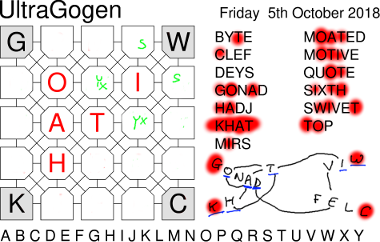UberGogen and UltraGogen Tutorial
Daily puzzles free to download and print out or buy books of 250 graded puzzles from Amazon.
|
When puzzles like these (the regular 'Gogen' puzzles) appear in newspapers and so on, there is only the vaguest of descriptions of what the thing should look like when you have finished but no real insight into how you should get there. In those sources, the defined cells are each corner, half way along each edge and in the middle - a total of nine out of the twenty five letters. I have found puzzles that have two cells with two letters left and and from the word list, no way of defining which letter should be in which of the two cells (leaving two solutions to one puzzle therefore a 'broken' puzzle) and in another puzzle, one of the letters was missed out completely (technically making it an UberGogen). On this site and in the books, I go beyond those simplistic puzzles and generate puzzles that deliberately have a number of letters missing (UberGogen) and puzzles that have numbers of defined letters missing (UltraGogen). In the case of the UberGogen, the missing letters often include a letter that is not defined so you can sometimes end up with a hole in your working within which you can insert the missing letter but, as it is solved using logic before it is even published on the Internet, it is soluble. With the UltraGogen puzzles, all of the 25 letters are in the word clues. With each, they become increasingly difficult as the week goes on. Here is how to solve the usually more difficult UltraGogen but the methods used here
apply equally to the UberGogen and the normal Gogen puzzles that appear elsewhere (assuming that they have been generated correctly). 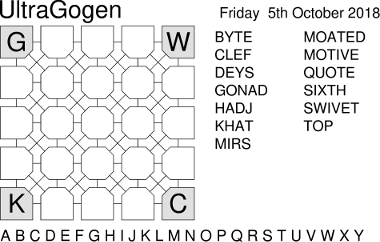
This is one of the puzzles as it appears when you opt to print out the PDF file - you get both on one sheet when you actually print it out. All you have to do now is to fill it in. There are a number of ways of doing this - some more efficient than others and sometimes you might miss something but logic will prevail and you won't make any errors if you follow logic. There are no logical ambiguities - there is only one solution to each puzzle. In this example, I'm going to show you a number of approaches which between them, work well for any of the puzzles. You might find that you are using one approach a lot and not using others and you might use some that aren't here but logic will solve it - after all, each puzzle is solved using only logic when it is created by the computer in the first place. If the computer can do it, you can. All we have to go on so far are the letters at the corners. 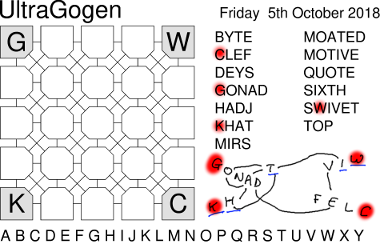
You can see from the highlighted letters in the word list that in the case of this puzzle, each defined letter in the puzzle appears only once in the word list. I find that it is easier to mark the letters in the word list - there is also a letter list across the bottom of the puzzle if you want to use it as well/instead. The way to look at the word list is to look at it as a list of pairs of letters that are next to each other, rather than a list of words. If it was a list of just pairs of letters, it would still work, it is just that words are used because it makes it easier for us humans. Having marked the letters, you now might find it useful to see if there are any strings of letters that travel the shortest distance across the diagonals of the puzzle - there is only one path for a diagonal and it is the shortest path. So, as this puzzle has letters in the corners, we need to see if there are any paths between G and C or K and W. So, on a piece of paper or, in this case, on a bit of space beneath the word list, start off writing the letters of the words that we have got, going in the direction we would like it to go - write GONAD from the top-left, towards the centre and CLEF from the bottom-right towards the centre. We find that the D of GONAD links to the E of CLEF - the link is in the last two lettes of MOATED. Also, in MOATED there is a direct link between O and A so that makes the link one shorter so we have GOADELC which is seven letters long - although this is only two letters longer than ideal, it is a bit on the long side so we look to see if we can do better. Looking the other way KHAT has an A in it that is in GONAD making GOAHK which is only five letters but runs vertically which is a bit flabby in the middle as it can run to half way across the puzzle. In the top-right we write WI and then we can pick up the T from KHAT and continuing with WIV, the E is picked up in CLEF. In KHAT, the T and the H can go next to each other (TH in SIXTH) and therefore we end up with WITHK which is only five letters long and runs diagonally so it is a nice tight straight line. 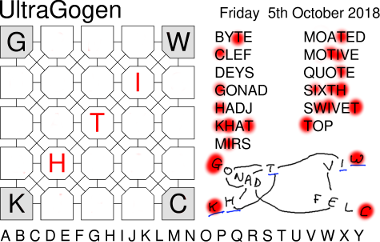
Now, GO of GONAD then OT of MOTIVE leads us from G in the top left to T in the middle - another diagonal. 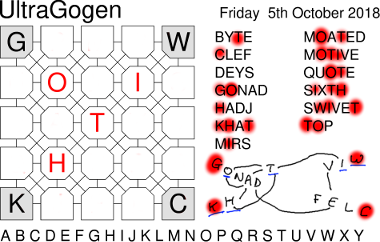
Next, we see that the A is linked to: the O and T (MOATED); and, the H (KHAT) and there is only one cell that has that position. Following that, it would be nice if we could put in the letter D which goes next to the A - it can be tied down to the C in the bottom right by looking at the drawing we made at the beginning. CLEDA (CLE of CLEF, ED of MOATED and DA of GONAD) is five letters long but unfortunately, there are two positions where the D could go next to the A where CLEDA matches up - above and below the T in the middle. So, we'll have to see what else we can do.
If we look at SIXTH and SWIVET, we can see that S is next to both W and I in the top right quarter. We can't tie down which of the two is the S yet but knowing that it can only be one of those two can be useful because now, we can look at things that are next to S. Like the S, X lies between the I and the T in SIXTH so we can mark the two cells that X appears in in the same way. Now, if we look at Y, we see that it is next to an S (DEYS) and next to a T (BYTE). Again, this is two cells but importantly, it is the same two cells that the Y appears in. Now, we have two cells that have two letters in that appear only in those two cells so one of them must be an X and one a Y although we don't know which yet. The important thing is that these two cells can only have those letters and no others. That means that of the two cells that could have had a D in them, one of them can only have X or Y in it so the D must go in the other cell. 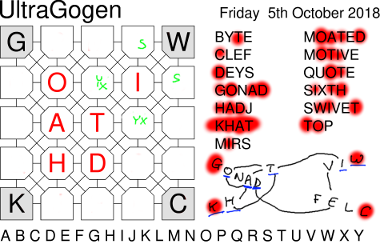
Looking at MOATED, the E has to go next to the T and the D. With our occupied cell containing XY, there is only one place it can go as well. 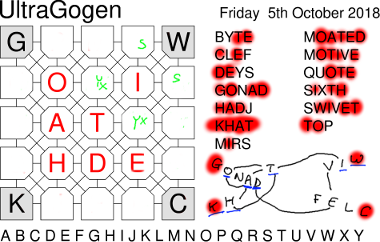
Now, looking at DEYS, we can easily see where the Y and S go and therefore also X. 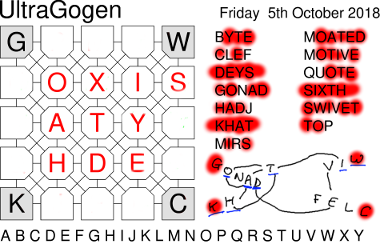
Now, looking at MOTIVE, we can see that the V goes between the I and E. Looking at BYTE, we know that the B has to go next to the Y. Also, looking at CLEF, the L goes between the C and the E. 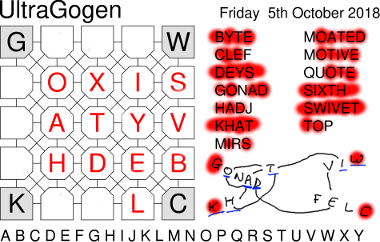
Next, in MIRS, the R goes between the I and the S and then the M is next to the I. Following that, looking at CLEF, the F goes next to the E. Then, looking at HADJ, the J goes next to the D. 
This is what it looks like now and there is nothing particularly obvious. In order to locate letters, so far we have used: Shortest diagonals (WITHK, GOT); Multiple neighbours (A-OTH); Saturation (SXY); and, Corners (VBLFJRM). Now, we have NPQU and four cells to put them in. All we know about each of them is what their neighbours must be from the words. 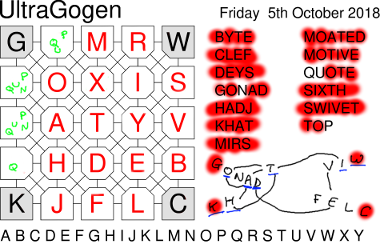
So, lets start off with N. We know from GONAD that it goes between O and A and there are two cells up the left that it can be. Nothing definite there. Look at the P in TOP. It must go next to an O so that narrows it down to three cells. The Q (in QUOTE) only attaches to the U and that isn't there yet so we'll do the U next. The U attches to the O and that is a total of three cells so we have nothing definite so far. However, the Q must go next to the U and whilst that applies to all four empty cells, one of them only has a Q in it. With no other letters left in the whole puzzle, we can say that that cell must be a Q and therefore, with it being at the end of a line, the one next to it must be a U. 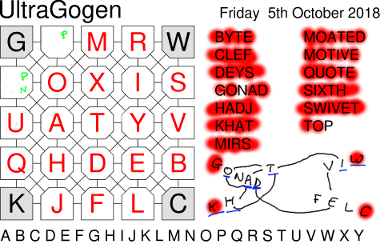
Removing the Q and U from the available letters in the remaining cells, we can see that the cell on the top row can only be a P and therefore the last cell must be the N. 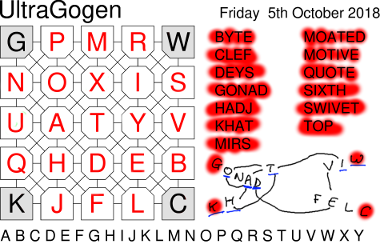
And that is the solution to the puzzle. If you want, you can check that each of the words works properly but by following the logical rules that we have, they must work unless you have made a mistake. So, just to recap, we have used the following methods to locate letters:
We haven't guessed anything, we have used only logic. |
Copyright ©2019-2023 Paul Alan Grosse.
